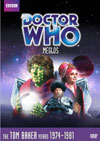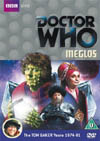Meglos
 |
 |
 |
DVD NTSC
Region 1




for North America
|
DVD PAL
Region 2


for the U.K.
|
VHS Video
NTSC


PAL


|
|
(Doctor Who Story No. 111, starring Tom Baker)
- written by John Flanagan and Andrew McCulloch
- directed by Terence Dudley
- produced by John Nathan-Turner
- music by Paddy Kingsland (part 1) and Peter Howell (parts 2-4)
- 4 episodes @ ~25 minutes each
|
Story: The scientific and religious
factions on the planet Tigella are too busy
squabbling with each other to realize that
a body-snatching cactus creature from a neighbouring
planet has plans to reclaim the mystical power source
that fell into the heart of Tigellan culture.
After inviting the Doctor to help sort out
their problems, things are made worse when his
prickly doppelganger shows up instead....
|
|
DVD Extras include:
- Audio commentary by
Lalla Ward (Romana),
Christopher Owen (Earthling),
co-writer John Flanagan,
and composers Paddy Kingsland
and Peter Howell.
- "Meglos Men" retrospective featurette (18 min.) with
writers John Flanagan and Andrew McCulloch
and script editor Christopher H. Bidmead.
- "The Scene Sync Story" special effects featurette (11 min.) with
visual effects designer Stephen Drewett, and
cameramen Peter Leverick and Roger Bunce.
- Retrospective featurette (13 min.) on the life of Jacqueline Hill (Lexa / Barbara Wright),
with ex-producer Verity Lambert,
actors William Russell (Sir Ian Chesterton) and
Ann Davies (Jenny), and husband Alvin Rakoff.
- Isolated Music by Paddy Kingsland (Part 1) and Peter Howell (Parts 2-4)
- Photo Gallery music montage (4 min.)
- Pop-up Production Note Subtitles by Stephen James Walker
- "Entropy Explained" featurette (5 min.) on the science behind
one of season 18's running story arcs.
- Easter Egg
Buyers' Guide Review
by Martin Izsak
|
|
(A more in-depth analysis, containing "SPOILERS" and intended
for those who have already seen the program, can be accessed
here.)
|
I find myself absorbed in "Meglos" in a way that
"The Leisure Hive" (the previous story)
never approached. Chiefly, the characters, settings, and thematic elements
are all introduced with greater care in this story, and fare particularly
well in the first episode.
A common theme from
Barry Letts' previous era
reasserts itself,
as we witness a society neatly divided between science and religious
mysticism. Perhaps the most interesting aspect of this is the fact
that the society's leader belongs to both factions - he leads by
understanding both points of view and integrating them, and he says
that he holds the Doctor in high regard for being able to do the same.
Costume design enhances this by putting all the scientists in white
and the mystics in red, while leader Zastor has his own unique purple
robes. It actually looks as though the story is set to promote a
harmonious integration between the two factions as a model for
resolving the conflicts that arise between them.
However, we end up with
a more basic action story that is considerably less philosophically powerful.
It is chiefly Jacqueline Hill's strong acting, alongside the season's
most innovative music scoring, that encourages the audience to continue
to respect the mystics' and their culture.
The TARDIS interior features quite heavily as
another John Nathan-Turner era upgrade
shows itself - all the joins between the wall panels feature corrugated
pillars. At last the console room feels perfect. Well done. The story
doesn't skimp on materialization,
so the TARDIS is quite well represented in this one.
As with "The Leisure Hive", the Doctor would be better off with more
to do. Tom Baker himself is quite busy, but he spends
half of his screen time playing the villain as well, and the later
episodes are extremely short to begin with. The middle episodes
in particular seem to be really lacking in substance, but I think they
get away with it more easily than "The Leisure Hive", because they do
keep moving characters through environments they've never encountered
before, which keeps the level of exploration and sci-fi discovery high,
and makes for a good action plot.
I'll have to save much of the discussion of plot for the
in-depth analysis version to avoid spoilers here.
The final episode manages to make up for what earlier ones may be
missing, as the Doctor gets his due.
It is quite interesting
to note how Baker portrays his two roles here differently: Meglos is
typically sour and resentful, with a reverence for power whether it comes
from physics or political control. The Doctor, by contrast, is in jovial
happy-go-lucky spirits for the most part, smiling as often as possible,
and tackling his challenges with optimism and enthusiasm. This is a Doctor
I thoroughly enjoy. It is interesting to note that the Doctor we saw
in director Paddy Russell's stories like
"Pyramids of Mars" (story no. 82) and
"The Horror of Fang Rock" (story no. 92)
more closely resembles Meglos than the Doctor of this adventure, another
reason why I tend not to rate those adventures as highly as many others.
General Grugger and Lieutenant Brotadac turn out to be a great pair of
comedic characters in themselves - and the balance between humour and threats
seems to be more carefully done and successful than was typically the case
in previous seasons. I find Frederick Treves as Brotadac to be particularly
enjoyable. But I think the guest star who shines brightest in this one
is Jacqueline Hill. I can't say I cared much for her character Lexa
when I first saw the story, but after having a chance to see Hill help
shape the program in its first two years as Barbara Wright, it is wonderfully
nostalgic to see her take on yet another strong female role and do it
such wonderful justice, reminiscent of Barbara's imitation of the goddess
Yetaxa in
"The Aztecs" (story no. 6),
but this time played with even more conviction.
Most thankfully, the Deons
prove far, far more interesting than all of the cookie-cutter cults
that plagued the show from Hinchcliffe's era up to
"The Stones of Blood" (story no. 100).
|
I think we have here the best incidental score of the season.
Peter Howell and Paddy Kingsland are certainly the dominant musical
voices of season 18, and with Kingsland filling in for Howell on
the first episode, the final product is blessed with a successful
collaboration that uses both of their talents and creativity.
The Deon music certainly stands out most, thanks to the wonderfully
atmospheric and innovative work from the vocoder, providing a very
refreshing change from the usual organ music that Dudley Simpson
often used to back religion and organized ritual. But the rest of
the score is always beautifully varied and highly interesting as well,
beginning with Kingsland's more melodic establishing pieces from the first
episode, through Howell's fascinating and ever-enjoyable moody action
cues later on.
|
The complete Musical Score by Peter Howell and
Paddy Kingsland
is available on:
|
Special Sound by Dick Mills
from this story is available on:
|
|
Onto the effects, I think the model work deserves mention as well.
The Screens of Zolpha-Thura are realized quite excellently, for although
the edges introduced around the characters during the CSO / green screen
compositing gives away the illusion a bit, this is more than made up for
by both the shadows that the human characters are able to cast onto the
model ground, and by the wonderfully computer-synced camera pans across
both actors and models during the composite shots. Very well done.
Unfortunately, we only get one shot of the thugs' spacecraft in
flight when the story could easily have done with more, and this one shot
is extremely lame.
Indeed, the design of the craft itself seems to be more concerned with
making something for which one can easily build a door in the studio,
rather than in making something that looks like it could actually fly.
The story also features some laser effects - thankfully Dave Jervis
took time to add visual beams in post-production. The sound for most
of the laser fire turns out to be so wimpy, however, that many scenes
have considerably less dramatic power than they ought to. Thankfully,
the best is saved for last....
In the end I think I have to say that I prefer Terence Dudley's
directing of this tale to Lovett Bickford's work on the
previous one - Dudley does a much better job of staying on story, thus
proving why tried and true methods have become as popular as they have.
John Nathan-Turner has produced another tasty tidbit of a story with
a lot of new-improved stylistic factors going for it, but JNT's
era still has yet to shine, particularly where story content and
writing is concerned....
This story is available on DVD and VHS video:
 |
 |
 |
DVD NTSC Region 1
for the North American market:

 in the U.S.
in the U.S.

 in Canada
in Canada
|
DVD PAL Region 2

 for the U.K.
for the U.K.
|
VHS Video
NTSC

 in the U.S.
in the U.S.
PAL

 for the U.K.
for the U.K.
|
Comments on this article are welcome. You may contact
the author from this page:
Contact page

LYRATEK.COM
|
Read the Buyers' Guide Review for the next story:
"Full Circle"

|
|










